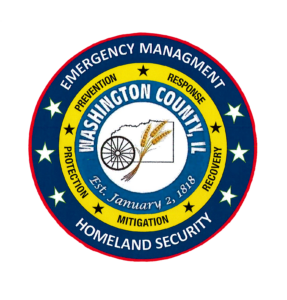Matt Bierman
Director
matt.bierman@washingtonco.illinois.gov
Darrah Sabo
Deputy Director
darrah.sabo@washingtonco.illinois.gov
Who are we?
Washington County EMA works to protect our communities by coordinating with local resources to mitigate against, prepare for, respond to, plan for, and recover from natural disasters, acts of terrorism, or other man-made disaster. Our primary goal is to support a safer, less vulnerable community through comprehensive plans and strong ties with our local first responders.
How did we get here?
Washington County EMA’s roots can be traced back to the cold war era when in 1951 the Illinois General Assembly established the Illinois Civil Defense Agency (ICDA) to cope with the consequences of a possible Nuclear attack. During the 1950s, emergency management was dominated by wartime civil defense activities that the government believed would prepare the nation.
A series of massive hurricanes and earthquakes during the 1960s and early 1970s served to focus public attention on natural disaster relief. Legislation soon followed, most notably in 1974 when the Disaster Relief Act was enacted, establishing a process for presidential declarations of national disasters.
EMA, as with Civil Defense has always been built on a volunteer based group of local residents that are willing to get involved with emergency related training and response to emergencies or disasters.
Over time some activities included severe weather preparedness and response assistance, assisting the fire and police departments with emergency calls that were larger events and more personnel were needed. Some activities included traffic control, lighting, and crowd control at accidents or fire scenes.
Civil Defense existed due to the war related threat, that’s all Civil Defense was supposed to be taking part in, war related activities which were limited. It wasn’t until the late 70’s when the Federal Emergency Management Agency (FEMA) was created and the all-hazard approach was taken with Civil Defense, now called Emergency Services and Disaster Agency (ESDA) in Illinois. Now ESDA could take part, legally and with backing from FEMA, with all types of emergency threats, most of which centered on tornado preparedness and response after a touchdown.
There has been one more name change in the agency; ESDA became the Emergency Management Agency (EMA). After the tragic events of 9-11 many things changed for everyone in the fire service, law enforcement, public works, local administrations, and emergency management. Because of lessons learned from 9-11, many new procedures are in place, training for everyone in all services and at all levels of government, and we are all working to achieve those goals.
In April of 2023 Governor Pritzker Signed an Executive Order renaming Illinois Emergency Management Agency to Illinois Emergency Management and Office of Homeland Security. This aligned more with what the Federal Government is doing with FEMA being under Homeland Security. Our functions and name changed as well.
So what do we do?
Led by professionals with years of experience in disaster response, Washington County EMA staff prepare plans and procedures for responding to natural disasters or other emergencies. The Washington County EMA Director is responsible for planning and leading the responses to natural disasters and other emergencies. We work closely with government agencies (both local and federal), nonprofits, private companies, and the public to develop effective plans that minimize damage and disruptions during an emergency. It is important that we regularly analyze the resources, equipment, and staff available to respond to emergencies. If resources are limited or equipment is lacking, we work within our means to obtain what is needed, sometimes from another community or even the State. One of EMA’s most important tasks includes setting up or teaching training courses and disaster exercises for staff, volunteers, and local agencies to help ensure an effective and coordinated response to an emergency. EMA staff also may visit schools, hospitals, or other community groups to provide updates on plans for emergencies. During an emergency you can find us maintaining a command center where we can monitor and manage the emergency operations. Our Director helps to lead the response, prioritizing certain actions if necessary. These actions may include ordering evacuations, conducting rescue missions, or opening public shelters who find themselves with nowhere else to go. With the name change we are now also responsible for Cyber security, Terrorism response, Civil Unrest and School Safety. We will be working very closely with the Washington County Sheriff’s Office to fulfill our new obligations.
How can I help?
One of the best things you can do, is prepare yourself and your family. The time to prepare is now, not right when a disaster strikes your community. Practice regular fire drills at home, make sure each family member has a “Go Bag” (a bag that contains essential items in the event you need to leave your house quickly), store water and shelf stable food in case of a power outage. For those who wish to go above and beyond personal preparedness, there is the EAB (otherwise known as the Emergency Auxiliary Brigade). Established in 2022, the EAB is a rapidly growing volunteer group who is affiliated with the Washington County IL Emergency Management Agency. Membership in the Emergency Auxiliary Brigade is open to anyone with a desire to serve their community and Washington County IL. Although the focus of the EAB is on emergency operations and public events, first responder experience is not an absolute prerequisite for service with the team; all volunteers will be made welcome. Volunteers with no experience are to be offered training to they may assist with essential support functions. The mission at Washington County EAB is to train and deploy volunteers with first responders locally to save lives, reduce property loss, and aid in disaster recovery through preparedness, response, and mitigation.

